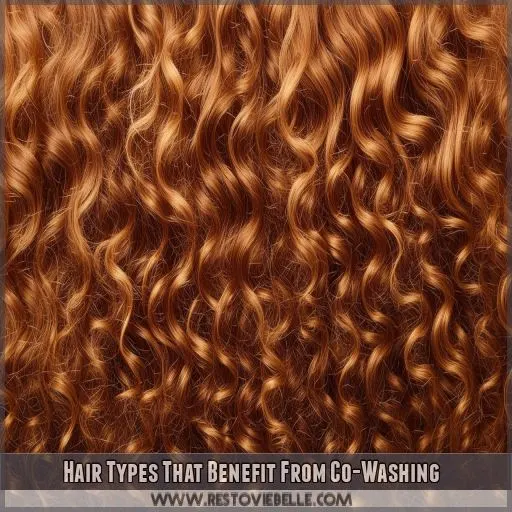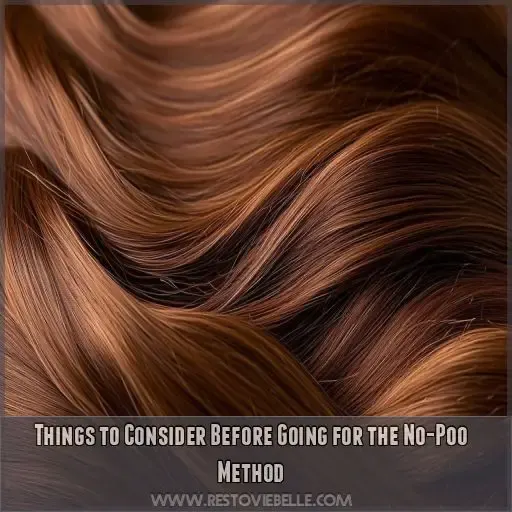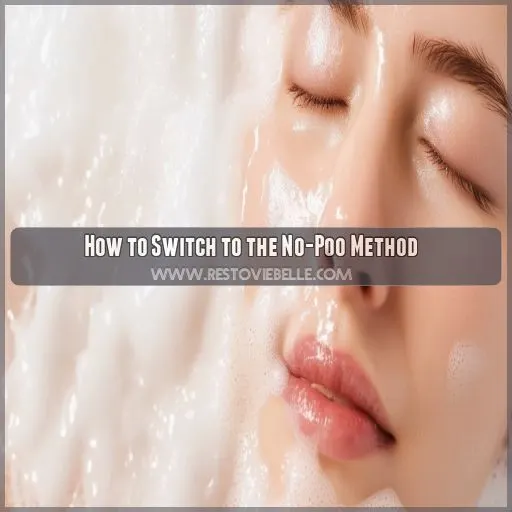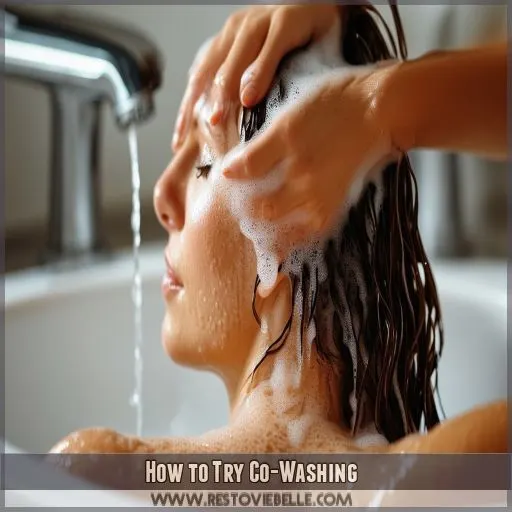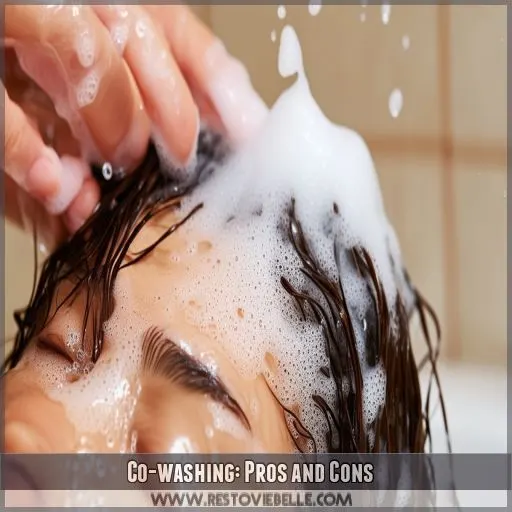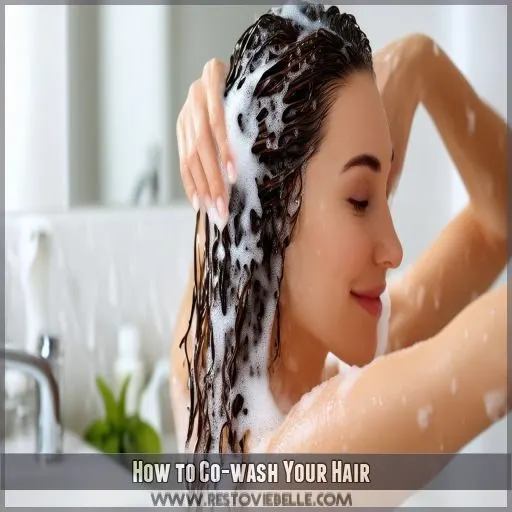This site is supported by our readers. We may earn a commission, at no cost to you, if you purchase through links.
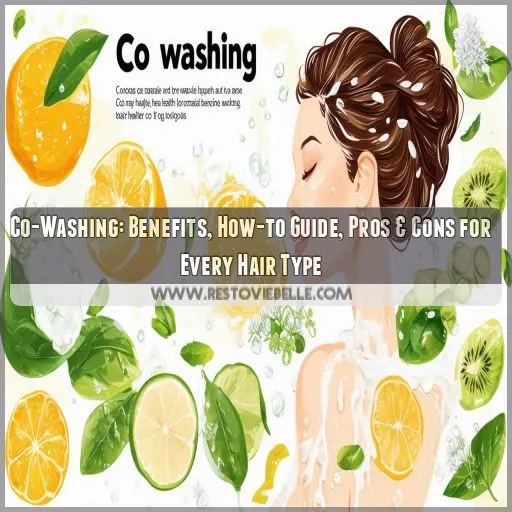 Learn how a conditioner-only wash could completely change the hair game.
Learn how a conditioner-only wash could completely change the hair game.
Other benefits of co-washing are given to many hair types: cleaning one’s hair using a conditioner helps decrease dryness and breakage.
We’ll take a closer look at what co-washing entails, the pros and cons, and a step-by-step guide created specifically for curly, wavy, delicate, and 4C hair to get the hang of co-washing and see if it’s for you
Table Of Contents
- Key Takeaways
- What is Co Washing, and How Does It Benefit Your Hair?
- What is Co-washing and the No-Poo Method About?
- Hair Types That Benefit From Co-Washing
- Pros & Cons of Co-Washing
- Things to Consider Before Going for the No-Poo Method
- How to Switch to the No-Poo Method
- How to Try Co-Washing
- Co-washing: Pros and Cons
- How to Co-wash Your Hair
- Frequently Asked Questions (FAQs)
- Is co-washing good for your hair?
- Does washing hair with hot water affect its health?
- What is co-washing hair?
- Can co-washing change your hair?
- Which conditioners are best for co-washing?
- How often should co-washing be done?
- Can co-washing help with dandruff?
- What are alternative clarifying methods for co-washers?
- How do you prevent buildup when co-washing?
- Conclusion
Key Takeaways
- Co-washing can be a game-changer for your hair care routine, offering a gentle yet effective way to maintain healthy locks.
- Co-washing is beneficial for your hair as it hydrates, reduces breakage, and maintains natural oils, making it softer and smoother.
- If you have curly, wavy, delicate, or 4C hair, understanding what co-washing is and how it benefits your hair is key.
- Remember to assess your hair type, manage buildup, and maintain scalp health. With co-washing, you may find your hair softer, more hydrated, and resilient against damage
What is Co Washing, and How Does It Benefit Your Hair?
Co-washing, short for conditioner washing, is a gentler alternative to shampooing where you cleanse your hair using a conditioner. It’s especially beneficial for curly, coily, and dry hair types as it retains natural oils, hydrates, and reduces frizz.
This method can help enhance curl definition, minimize breakage, and maintain moisture. While co-washing is generally great for many hair types, those with fine or oily hair should choose lightweight, silicone-free conditioners to avoid buildup.
Ready to learn how co-washing might transform your hair care routine? You’re about to discover all you need to know!
What is Co-washing and the No-Poo Method About?
Co-washing, also known as the "no-poo" method, is an alternative to traditional shampoo-based hair washing. Instead of using a shampoo, you cleanse your hair using a conditioner or a cleansing conditioner.
The idea behind co-washing is to hydrate and moisturize your hair while still removing dirt, oil, and product buildup. This gentle approach can be especially beneficial for those with dry, curly, or coily hair types that tend to be prone to dryness and breakage
Hair Types That Benefit From Co-Washing
Co-washing is a very effective technique of hair management for most hair textures, be it curly, 4C, wavy, or acceptable; it keeps them well moisturized and reduces frizz. Therefore, knowing how co-washing affects your type of hair makes a somewhat informed decision in using it for its optimum care.
For Curly Hair
curly hair thrives with co-washing, offering multiple benefits to your hair care routine. By adopting co-washing, you can:
Keep the moisture in, reducing dryness.
- Enhance curl definition for a polished look.
- Minimize frizz, promoting smoother strands.
- Retaining natural oils, which result in overall hair health.
Try incorporating co-wash products into your regimen for optimal results
For 4C Hair
Co-washing can be highly transformational to 4C hair. The added moisture and reduced breakage work like magic on tightly coiled textures. To avoid product build-up and help scalp health, use a silicone-free conditioner.
The key to co-washing the hair is the frequency. It will allow hair to be detangled while retaining natural oils in the hair for healthy and manageable hair.
Use products that are made for oily hair
For Wavy Hair
Co-washing can work wonders for wavy hair. It maintains moisture, reduces frizz, and keeps your waves looking lush. Keep in mind:
- Use lightweight conditioners to avoid weighing down your hair.
- Incorporate deep conditioning treatments occasionally.
- Transition gradually by alternating between co-washing and mild shampoos.
These steps help balance hydration and cleanliness
For Fine Hair
For fine hair, co-washing can weigh it down if not done correctly. Opt for lightweight, silicone-free cleansing conditioners. Focus on scalp care to avoid buildup. Here’s a quick table comparing options:
| Concerns | Remedies |
|---|---|
| Product Buildup | Use clarifying treatments occasionally |
| Lack of Volume | Choose ultra-light formulas |
| Scalp Care | Massage thoroughly, rinse well |
Balancing moisture and cleansing is key
Pros & Cons of Co-Washing
Co-washing offers numerous benefits, like detangling and moisturizing your hair while reducing chemical exposure. However, it may also lead to product buildup and isn’t always ideal for those with thin or thick hair if not done correctly
Pros
Co-washing benefits many hair types by offering:
- Moisture Retention: Co-washing maintains your hair’s natural oils, keeping it hydrated.
- Reduced Frizz: Conditioner-only washing helps smooth the hair cuticle, reducing frizz.
- Gentle Cleansing: Co-washing is less harsh than traditional shampoos, making it perfect for dry, wavy, and curly hair
Cons
While the benefits are tremendous, co-washing can cause some buildup, particularly when it isn’t rinsed away fully. Excessive build-up can also help to market scalp conditions or irritation and thus deter hair health.
Co-washing may not remove the sweat and dirt, leaving hair feeling less clean. Some hair types may find it difficult to be consistent with this method, such as fine or ultra-thick hair. It’s important to recognize these cons before making changes to the products you’re using
Things to Consider Before Going for the No-Poo Method
Before switching to the no-poo method, you’ll need to consider if it’s compatible with your hair type, as it may not work for everyone. It’s also important to understand how buildup and cleansing will affect your scalp health to maintain a balanced routine
Hair Type Compatibility
When considering co-washing, it’s vital to assess your hair type compatibility. Different hair textures and needs demand varied approaches. Here are a few quick tips:
- Fine hair: May result in limpness.
- Thick hair: Application needs to be done quite.
- Wavy hair: Greatest for added hydration.
- Curly Hair: Requires more frequent cowashing.
4C hair: Will benefit from less breakage.
Choose accordingly!
Buildup and Cleansing
Are you considering the no-poo method? Buildup prevention is crucial. Without regular shampoo, your hair might accumulate residue from products and natural oils. Opt for a cleansing method like co-washing with a mild, silicone-free conditioner and incorporate a sulfate-free shampoo occasionally. Cleansing frequency and choice of products are crucial in maintaining scalp hygiene while adopting the routine.
Scalp Health Maintenance
Keeping your scalp healthy during co-washing is very important. One risks build-up, which later results in irritation and dryness. Here, then, are some handy tips:
- Identify Your Scalp: Look for signs of buildup or sensitivity.
- Clarifying Treatments: Use a light, sulfate-free shampoo at least occasionally to clarify.
- Hydrate and Condition: Ensure the product hydrates and conditions your scalp without irritation.
How to Switch to the No-Poo Method
Switching to the no-poo method means ditching traditional shampoo, replacing it with alternatives like co-washing. Consider your hair type, needs, and the chosen method to ensure a smooth transition
No Suds
Using the no-poo technique takes some getting used to with no lather and attention to rinsing hair material. The goal is for the scalp to be conditioned with moisture but not coated with conditioners that dry on the scalp. Make sure you scrub your scalp to keep from giving your scalp a dried-out appearance. Co-washing benefits any type of hair that’s curly and on the dry side or oily hair types using this hair care method.
| Hair Type | No Suds Effect | Moisture Retaining | Product Building Up | Focus on the Health of the Scalp |
|---|---|---|---|---|
| Curly | Less frizz | High | Moderate | High |
| Dry | Hydration Enhanced | Very High | Low | Moderate |
| Oily | Oil Balanced | Moderate | High | Critical |
| Wavy | Defined waves | High | Moderate | High |
| Fine | Lightweight feel | Moderate | Low | Essential |
Your Chosen Method
Choose your co-washing method based on your preferred results. For gentle cleansing, try co-washing products specifically designed for it. Want natural options? Consider a rice water rinse. Adjust your routine to meet your hair’s needs, whether it’s fine or thick. Remember to balance frequency and styling after co-wash to avoid buildup and maintain healthy hair
Your Hair Type
Transitioning your hair to a no-poo regimen? Take your hair type into consideration: texture, scalp sensitivities, hair porosity, curl pattern, and hair density. In each, the approach is different. The specifics here guarantee the most effective co-washing process for your hair—this way you feed it the best, for healthier and well-nourished hair.
What Does Your Hair Need?
Knowing what your hair needs is, therefore, very essential. If associated problems are hair growth and thinning, breakage, frizz, or hair getting tangled, co-washing would make your hair moist but not strip your natural oil.
Use products that are for your particular hair type and also ensure that you have a balance: cleansing versus moisturizing.
Remember that the benefits of co-washing go beyond traditional shampoos but are, at times, accompanied by the need for particular adjustments in your hair care routine
How to Try Co-Washing
To try co-washing, transition smoothly. Follow these steps:
- Choose the Right Conditioner: Pick a conditioner that’s free from silicones and is suited to your hair type. Great bets are Pantene Gold Series for relaxed hair and Afrocenchix Swirls for natural hair.
- Applying Techniques: Dampen your hair. Conditioner at the scalp—rub well; from there, massage through to the ends.
- Thorough Rinse: Rinse your hair twice as long because rinsing your hair is because of shampoo; too little leads to build-ups.
- Occasional Clarification: Use a mild sulfate-free clarifying shampoo 1x every 7 to 10 days for cleansing of the scalp and removing excess product, especially when you’re working with weaves, box braids, or locs.
Co-washing: Pros and Cons
Co-washing can be a great way to keep your hair moisturized and minimize damage, but it’s important to know that not all conditioners are suitable for this method. While co-washing does cleanse your hair, it mightn’t feel as clean as using shampoo, and you might still need to clarify your hair occasionally
Can You Use a Regular Conditioner as a Co-wash?
You might want to know if you can use an ordinary conditioner for co-washing. While you can, you’ll definitely want to choose one with the correct ingredients to support scalp health and prevent product build-up.
| Condition | Regular Conditioner | Co-Wash Conditioner |
|---|---|---|
| Ingredients | Moisturisers | Cleansers & moisturisers |
| Scalp Health | Potential buildup | Designed for balance |
| Performance | Heavy for regular use | Formulated for frequent use |
| Hair Types | Overall | Specifically formulated for co-washing |
| Cost | Often cheaper | May cost more |
Choose wisely!
Does Co-wash Count as Washing?
It can be counted as washing, but it’s gentler than shampoo. The water in the co-wash rehydrates hair and gives it life with minimum breakage.
However, this method tends to build up in the hair and irritate scalp health or sometimes doesn’t clear out all the sweat, dead skin, or dirt it should.
Clarify once in a while with a shampoo that will rid all the residue to truly take care of your hair for conditions like eczema on the scalp or with transitioning hair
How to Co-wash Your Hair
To co-wash your hair, start by wetting it thoroughly and massaging a silicone-free conditioner into your scalp. Rinse out the conditioner thoroughly, then use a leave-in conditioner if needed
Do You Use Co-wash Before or After Shampoo?
Co-washing typically replaces shampooing in your routine, so you’d use it instead of your regular shampoo. It’s not common to use co-wash before or after shampoo because co-washing is designed to cleanse and moisturize in one step. This method is particularly useful for maintaining hair care for hair folliculitis, ringworm, impetigo, cellulitis, or abscess
Do You Wash Out Co-wash?
Yes, you should wash out co-wash.
Massage the conditioner into your scalp, working down to the ends, then rinse very well. This prevents product build-up so that your hair feels clean.
Doubling the time taken to rinse can be paramount in ensuring that all co-wash products are washed out, especially if there’s an issue with the scalp, like alopecia or dermatological conditions
How Often Should You Co-wash?
You should co-wash your hair every 7-10 days, depending on your hair type and need. Coarser hair may go longer between co-washes, whereas curly or drier textures benefit most from it often. Remember, too much can create a buildup, so finding what works for you best breaks the code for healthy, hydrated hair.
Frequently Asked Questions (FAQs)
Is co-washing good for your hair?
Co-washing is beneficial for your hair as it hydrates, reduces breakage, and maintains natural oils, making it softer and smoother. However, it may not fully cleanse the scalp and can cause product buildup
Does washing hair with hot water affect its health?
Yes, washing your hair with hot water may remove natural oils from it and make it dry and easily damaged. Use lukewarm water to balance the moisture and have healthier hair.
What is co-washing hair?
Co-washing is like giving your hair a hydrating spa day; you cleanse with conditioner instead of shampoo. It helps moisturize, maintain natural oils, reduce frizz, and is excellent for curly or coily hair types
Can co-washing change your hair?
Yes, co-washing can change your hair. It hydrates, reduces breakage, and softens curly or coiled textures, while maintaining natural oils. However, improper use might lead to buildup or scalp issues
Which conditioners are best for co-washing?
For effective co-washing, choose conditioners like Afrocenchix Swirl Silicone-Free Conditioner, Pantene Gold Series Deep Hydrating Co-Wash, Shea Moisture Curl Moisture Co-Wash, Live Clean Apple Cider Ultra Light Conditioner, or Lush Avocado Co-Wash
How often should co-washing be done?
Co-wash 1-2 times a week. Interestingly enough, 65% of curlies prefer co-washing over regular shampoo. Doing it frequently will help maintain your hair at a balanced level of moisture and can prevent product build-up, which may cause scalp issues.
Can co-washing help with dandruff?
Co-washing does help with dandruff, but it’s not enough alone. I mean, moisturizing and eliminating dryness relieves dandruff. That, coupled with an anti-dandruff treatment, makes sure of better results.
What are alternative clarifying methods for co-washers?
You can clarify your hair by using baking soda and apple cider vinegar, a rice water rinse, or a mild sulfate-free shampoo every 7-10 days to remove buildup and maintain a healthy scalp
How do you prevent buildup when co-washing?
To prevent buildup when co-washing, use silicone-free conditioners, rinse thoroughly, and incorporate a mild, sulfate-free shampoo every 7-10 days to clarify your scalp and hair, removing excess product and maintaining scalp health
Conclusion
Embracing co-washing can be a game-changer for your hair care routine, offering a gentle yet effective way to maintain healthy locks. Whether you have curly, wavy, delicate, or 4C hair, understanding what co-washing is and how it benefits your hair is key.
Remember to assess your hair type, manage buildup, and maintain scalp health. With co-washing, you may find your hair softer, more hydrated, and resilient against damage. Ready to give it a try? Your best hair awaits


